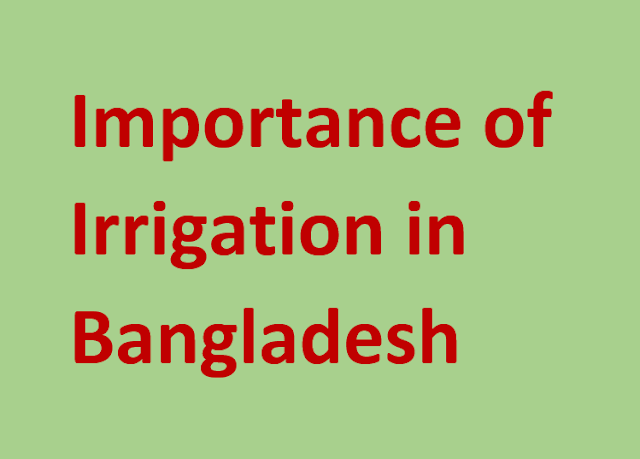 |
| Importance of Irrigation in Bangladesh. |
Importance of Irrigation in Bangladesh
Bangladesh enjoys subtropical climate due to the effect of the Himalayas and the Bay of Bengal and experiences heavy showers during kharip season. Average rainfall of the country exceeds 220 cm per annum. An average precipitation of 50 cm is often considered the minimum for cropping without irrigation and successful production of most of the crops requires only 100-150 cm rainfall annually. So, apparently there is no scope and importance of irrigation in Bangladesh agriculture. But, the frequency and distribution of rainfall are more important in determining the irrigation need than the total amount. A thorough look over the pattern of rainfall distribution in Bangladesh presented in reveals the following facts:
i. Summer months get maximum rainfall and May, June, July, August and September experience over 80% of the total rainfall.
ii. ii. About 57% of the rainfall occurs in the month of June -August.
iii. iii. Winter months (October-March) are almost rainless.
District wise rainfall distribution pattern shows two distinct zones. One is high rainfall belt (250-500 cm rainfall) comprised of Sylhet, Chittagong, Chittagong Hill Tracts, Noakhali, Mymensingh and another is low rainfall belt (around 150 cm rainfall) of Rajshahi, Kushtia, Jessore, Rangpur, Dinajpur and Bogra districts. As a matter of consequences of the above facts, the maximum cultivable land (over 60%) is devoted to kharif season where there is abundant rainfall. Whereas, in rabi season, only 40% of the total cropped land is possible to put under cultivation and vast lands remain barren in want of adequate soil moisture. In fact, rabi crops in non-irrigated condition include some minor crops which just suit to use up the residual soil moisture only. As a result, the crop production practices are very much affected under natural rainfed condition. So, the importance of irrigation can be judged in consideration of the following points:
i. Bringing more land under cultivation in rabi season.
ii. Maximization of crop yield
iii. Crop quality improvement
iv. Crop insurance
v. Adjustment of planting time
vi. Change of cropping pattern vii. Increase of cropping intensity
In the earlier tradition of cropping, the area devoted to boro rice is very much limited and it only includes the low lands of beels and haors where there is plenty of natural water throughout the cropping season. However, with the extension of irrigation facilities, the boro-cropped area has now been considerably increased on medium and even on high lands.
Thus, in view of the above facts, the importance of irrigation is tremendously felt for the production of crops in rabi season and in low rainfall areas. It is essential then to mention that adoption of irrigation is one of the key points to change our so called rainfed age-old agriculture.
If you can’t understand something please comment below…